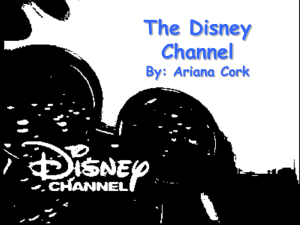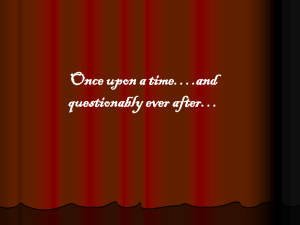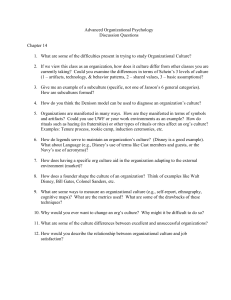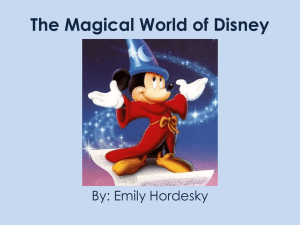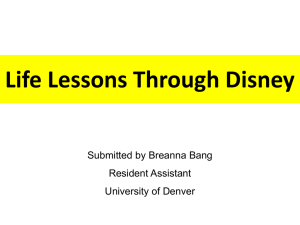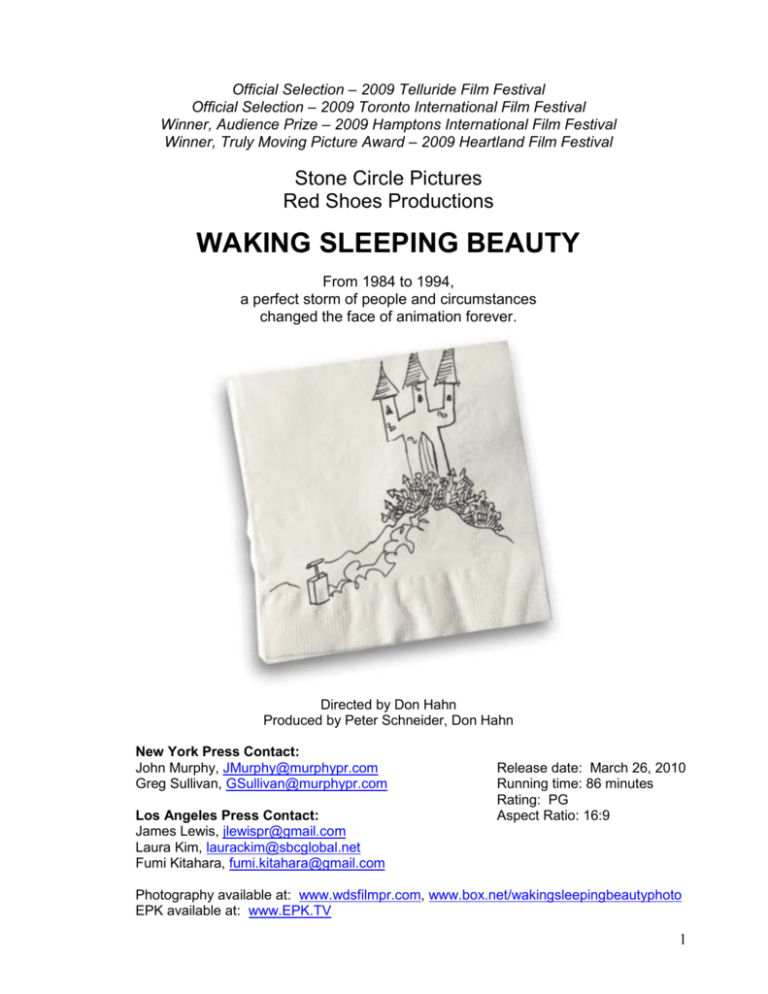
Official Selection – 2009 Telluride Film Festival
Official Selection – 2009 Toronto International Film Festival
Winner, Audience Prize – 2009 Hamptons International Film Festival
Winner, Truly Moving Picture Award – 2009 Heartland Film Festival
Stone Circle Pictures
Red Shoes Productions
WAKING SLEEPING BEAUTY
From 1984 to 1994,
a perfect storm of people and circumstances
changed the face of animation forever.
Directed by Don Hahn
Produced by Peter Schneider, Don Hahn
New York Press Contact:
John Murphy, JMurphy@murphypr.com
Greg Sullivan, GSullivan@murphypr.com
Los Angeles Press Contact:
James Lewis, jlewispr@gmail.com
Laura Kim, laurackim@sbcglobal.net
Fumi Kitahara, fumi.kitahara@gmail.com
Release date: March 26, 2010
Running time: 86 minutes
Rating: PG
Aspect Ratio: 16:9
Photography available at: www.wdsfilmpr.com, www.box.net/wakingsleepingbeautyphoto
EPK available at: www.EPK.TV
1
2
WAKING SLEEPING BEAUTY
From 1984 to 1994, a perfect storm of people and circumstances
changed the face of animation forever.
SYNOPSIS
By the mid-1980s, the fabled animation studios of Walt Disney had fallen on hard times.
The artists were polarized between newcomers hungry to innovate and old timers not yet ready to
relinquish control. The conditions produced a series of box office flops and pessimistic forecasts:
maybe the best days of animation were over. Maybe the public didn’t care. Only a miracle or a
magic spell could produce a happy ending.
Waking Sleeping Beauty is no fairy tale. It’s the true story of how Disney regained its
magic with a staggering output of hits—“The Little Mermaid,” “Beauty and the Beast,” “Aladdin,”
“The Lion King” and more—over a 10-year period.
Director Don Hahn and producer Peter Schneider bring their insider knowledge to Waking
Sleeping Beauty. Hahn was one of the Young Turks at Disney who produced some of its biggest
sensations. Schneider led the animation group during this amazing renaissance and later became
studio chairman. Their film offers a fascinating and candid perspective of what happened in the
creative ranks set against the dynamic tensions among the top leadership, Michael Eisner,
Jeffrey Katzenberg and Roy Disney (the nephew of Walt).
The process wasn’t always pretty. The filmmakers bring a refreshing candor in describing
ego battles, cost overruns and failed experiments. During times of tension, the animators’ favorite
form of release was to draw scathing caricatures of themselves and their bosses. Director Hahn
puts several memorable ones on display and marshals a vast array of interviews, home movies,
internal memos and unseen footage.
Announcing the world premiere of Waking Sleeping Beauty at the 2009 Toronto
International Film Festival, the festival’s documentary programmer Thom Powers said, “Waking
Sleeping Beauty celebrates the rich history of Disney animation and honors the many writers,
artists and composers who created the Disney magic. The treatment is so thorough that it
includes key figures who famously left Disney such as Don Bluth, John Lasseter and Tim Burton.
At one time, children imagined that Walt Disney’s signature meant a film was the creation of one
man. This is a more grown-up portrayal that reveals the collaborative, often contentious,
experience in all its complexity.”
3
MAKING WAKING SLEEPING BEAUTY
For 10 years, producer Peter Schneider contemplated the idea of making a documentary
about the incredibly fertile and turbulent decade that produced some of Disney’s most successful
films and revitalized the animation industry. There had been plenty of reporting about this
moment in Disney history, but none of it told the complex, riveting story that Schneider had
witnessed up close.
“The articles and books that have been written never captured the whole story because
they were told from an outsider’s point of view,” says Schneider. “They didn’t capture the joy of a
group of creative people firing on all pistons or the unique drama among the key players as they
clashed over who would take credit for the renaissance of the animation department.
“Once animation became the ‘heart and soul’ of the company again, everybody started
vying for a piece of it,” he says. “Feature Animation was central to the drama.”
Schneider and Don Hahn, the film’s director, were both present during the era they have
documented in Waking Sleeping Beauty. “The story parallels the animated films themselves,”
Hahn points out. “They’re all about love and conflict. Waking Sleeping Beauty is about the love
of a group of people for an art form and the conflict that occurred when that art form became
incredibly lucrative and prestigious.”
Both Schneider and Hahn had been deeply involved in the creation of films including “The
Little Mermaid,” “Beauty and the Beast,” “Aladdin” and “The Lion King.” Many years later, they got
together. “As with most good films, the idea for this one started in a coffee shop,” says Hahn. “As
we sat down with our lattes, we inevitably started talking about our time together at Disney.”
They recalled their years at the studio with mixed emotions of euphoria and horror. They
had been part of a team that produced a series of films that were phenomenally successful
artistically and financially. “On the other hand, it took its toll,” says Hahn. “And it left us with some
incredible Hollywood stories to tell.”
Initially, Hahn was concerned that the story covered too many movies, too many
characters and too much time to be told succinctly. “It’s a rich period with some of the most
dynamic personalities in the history of entertainment,” he says. “How are you going to capture all
that in a 90-minute film?”
But Schneider convinced him that they were in a unique position to tell the real story. “We
were in the room,” says Schneider. “We probably knew too much about what happened.”
“But,” adds Hahn, “we thought that if we could tell that story in as honest a way as
possible, it would be an amazing tale: Shakespearean characters and palace intrigue mixed with
cartoons. Who wouldn’t love that?”
4
The filmmakers first enlisted the support of Dick Cook, who at that time was chairman of
The Walt Disney Studios. He had worked side by side with Schneider and Hahn during those
years. “We warned him the film might stray into difficult areas,” says Schneider. “Without
hesitation, Dick said ‘Yes.’”
They all felt enough time had passed that the central players on both the artistic and
business sides would be willing to speak openly. “It would be at the least cathartic, and possibly
an instructional parable for the future,” Hahn says. “Dick recognized that it was a unique time in
all of Hollywood—a perfect confluence, as he put it, of executive boldness, artistic excellence and
sheer luck.”
Although the film shows the studio in a less than positive light at times, Cook’s backing of
the film never wavered. “There were many late nights when I was tearing my hair out trying to tell
a tough story,” says Hahn. “I was always wondering if there would be some ‘day of reckoning’ on
the film, a day when we would be asked to censor it and edit down some of the more unflattering
passages. That day never came.”
The next hurdle was securing the cooperation of Michael Eisner, Roy Disney and Jeffrey
Katzenberg. Fifteen years had passed, but they had never before gone on record with their
personal memories of that time. “For a long time, it was too raw for them to be able to speak
about,” says Schneider. “The biggest surprise for me was how frank everyone was. There was a
consensus that the story needed to be told.”
The intervening years had a cooling effect on the former rivals. “At that point, there was no
reason for them not to talk about it,” continues Schneider. “No one was feuding. They had each
made peace with themselves.”
“In fact,” says Hahn, “Roy Disney was eager to talk. And Jeffrey Katzenberg couldn’t have
been more cooperative. Michael was apprehensive at first, but when he saw our approach to the
material, we gradually won him over.”
It was unavoidable that the filmmakers, who were so intimately involved in the events they
were retelling, would bring their own points of view to the story. “I realized very early that my truth
on this topic would not always jibe with Peter’s truth or the truth of the other participants,” says
Hahn. “We decided to interview all the players and let them describe their own experiences –
their own ‘truth,’ -- sort of like 10 blind men describing an elephant. We had some of the best
storytellers on earth, why not let them tell their stories in their own words about this insane,
creative thrill ride we all lived through.”
To maintain some distance from their material and emotional connection to that period,
Schneider suggested that Patrick Pacheco, a veteran journalist who has written for The New York
Times, The Los Angeles Times and The Wall Street Journal, conduct the interviews.
“It was important to have someone involved who challenged our assumptions,” Schneider
5
says. “We thought Pacheco could better elicit some provocative material from the interview
subjects. So we sent him off with his tape recorder and a list of names. We thought we could
capture the story by interviewing 20 people. He interviewed OVER 75.”
“Peter and Don made the contacts and then got out of the way,” says Pacheco. “They
made no demands except to tell me that they were looking for an emotional and dramatic story. It
became clear early on that Howard Ashman was its poignant heart, not only because of his
untimely death but also because of his crucial role. At one point, Roy Disney even compared him
to Walt in terms of his influence.”
Pacheco’s interviews uncovered some other surprises for the filmmakers. “Another
revelation was the key diplomatic role played by Frank Wells in the delicate balance among Roy,
Jeffrey and Michael, something which had never before been explored in accounts of this period,”
says Pacheco. “I assumed that Frank’s value to the company was his business acumen. But his
talents as a diplomat were just as important—if not more so—to the success of this period.
“It was striking how Roy’s behavior was molded by his innate sense of responsibility,
because he alone carried the name Disney and how subtly he was able to wield that power,” says
Pacheco. “To my surprise, Jeffrey and Michael were also open in talking about past grievances. It
was almost as if they were using the interviews as an opportunity to speak to each other after a
long, deep freeze.”
“It’s really a classic Hollywood story in that it reminds us that this town was built by a
bunch of ambitious, eccentric and passionate artists, which included Walt Disney and his
successors,” says Pacheco.
Waking Sleeping Beauty painstakingly balances the sometimes conflicting points of view
of the animation team members and the studio chiefs who competed against each other for
control and credit. However, Schneider observes, “It was not us versus them. Sure, the artists
can be a subversive lot. Believe me, I took a lot of hits when I first arrived at Disney and they are
in the movie. But we all got into the trenches together and that led to a mutual respect.”
And as Eisner says in the film, “Go to any institution, any university, any hospital, any
corporation, any home, any house, you know what, the human condition overshadows bricks and
mortar, every time. And it's about fear, and envy, and jealously, and comfort, and love, and hate,
and accomplishment. Every institution has it. Were we a bunch of artistic, emotional people
running around screaming and crying and ranting and raving? No, it was an organized group of
people, working together, saying, let's put on a show.”
This often contentious collaboration resulted in a “perfect storm” of talent which led to an
extraordinary renaissance of the art of animation, which led to artistic recognition, a lot of
attention, and incredible box office grosses.
Large egos and infighting are legendary in Hollywood, but much of it usually stays behind
6
closed doors. The power struggle at Disney played out in a uniquely public way and the rumors
and reality coming out of the studio transfixed the Industry.
“Disney offered one of the biggest stages on earth for the personalities to surface,” says
Hahn. “With success came magazine covers and talk show appearances—and not just for the top
brass. Prior to that, the animation industry had been one of the most anonymous professions on
earth, not unlike monks copying bibles.. Suddenly the artists got their 15 minutes of fame and
more. With fame came ego, and with all the good press, it was easy to start believing that you
deserved to be in the spotlight. It’s fleeting, as the film shows.”
Prior to 1984, animated films were produced through what Hahn calls “a well-tooled
production pipeline.”
“The era from 1984 to 1994 was more akin to a gasoline fire,” says Hahn. “It was a time
of high productivity, stressful debate on every creative grain of the movie, and intense pressure to
out-do the last accomplishment. It was chaotic, exhausting and thrilling.”
When conceiving the documentary, the filmmakers posted two key rules over the AVID
editing system: “No talking heads. No old guys reminiscing.”
”It was Don Hahn who came up with the idea to use only footage that was shot during this
10-year period, with current voiceover,” says Schneider.
“Using only the archival footage from that era was the big breakthrough,” Hahn adds, “I
wanted to transport the audience into the rooms where Peter and I sat, into the eye of the storm.
And we were really fortunate because unauthorized photography was always strictly
prohibited on the Disney lot, but some of the best and rarest footage comes from animator Randy
Cartwright,” Hahn continued. “Cartwright would covertly walk the halls with his cameraman, a
young John Lasseter, and film the inner workings of the animation division. This rare glimpse into
the studio became the centerpiece of the documentary’s first act.”
“What makes it even funnier is that studio head Ron Miller walks into what is essentially
Randy’s opening shot,” says Hahn. “Randy could have been thrown into jail, but thanks to a
good-natured Miller, the footage survived.”
Cartwright’s home movies lend immediacy to the story that transports the viewer back in
time. “I wanted that voyeuristic feeling of actually walking the hallways and being there in the
room,” says Hahn. “We see these guys – Glen Keane, Tim Burton, John Musker, Ron Clements,
John Lasseter -- operating at the very beginning of their careers.”
Writer Jim Cox shot another round of film during the making of “Oliver & Company,” this
time capturing a young Peter Schneider, “Oliver” director George Scribner, and some precious
footage of the late Vance Gerry and Joe Ranft at work in their story room.
The filmmakers were given access to all the archival vaults at Disney for clips, and
discovered another, more unorthodox source for some unique images: Hahn’s mother. She had
7
taped television coverage when the films first came out.
Schneider and Hahn also were able to choose from a rich catalogue of caricatures
created by artists for an annual show that was held each year to lampoon them and their bosses.
“There were thousands of the funniest, nastiest caricatures imaginable to choose from,” says
Hahn, “so the biggest problem was selecting which drawings were best to tell the story.”
Greed, envy, hope, desire, passion, jealousy, fear and love are the stuff of great movies.
They also worked behind the scenes of one of the greatest Hollywood dramas in history. “You
name it, and it was there,” says Hahn. “We were people with hopes and ambitions who lived with
each other as a family in order to make the best movies we could.”
“Making the film was emotional, cathartic and difficult,” says Hahn. “But when I look back,
at those years, I do so with equal parts pride, joy, sadness and humility. Pride in what we
accomplished together with some paint, pencils, paper and persistence, and sadness at the loss
of Howard Ashman, our friend and mentor.”
“I’m humbled to this day by the audience’s reaction to these films, and happy to have
been in the right place at the right time to see it all happen,” Hahn continues. “It was a winning
season, in every way as exciting and hard fought as any winning season in any sport. And we
were lucky to be players.”
“So many people grew up with the movies created during that period,” says Schneider.
“This is the story behind those films and it’s a story you can’t get from any other source. In the
‘50s, Walter Cronkite had a series called ‘You Are There.’ Well, it’s Disney, 1984 to 1994. And
you are there. I hope the audience will find it as amusing, passionate, emotional and provocative
as those years were for Don and myself.”
ABOUT THE FILMMAKERS
Don Hahn (Director) is one of the most successful filmmakers working in Hollywood
today. He produced the Disney classic “Beauty and the Beast,” the first animated film to receive a
Best Picture Oscar® nomination from the Academy of Motion Picture Arts & Sciences, and to win
a Golden Globe® for Best Picture. His next film, “The Lion King,” broke box office records all over
the world to become the top-grossing traditionally animated film in Disney history and a longrunning blockbuster Broadway musical. Hahn also served as associate producer on the landmark
motion picture “Who Framed Roger Rabbit” (with Amblin’ Entertainment). His other films include
“The Hunchback of Notre Dame,” “Atlantis: The Lost Empire” and the 2006 short, “The Little
Matchgirl,” which earned Hahn his second Oscar® nomination.
He directed “Waking Sleeping Beauty,” a documentary about Disney Animation from
1984-1994. It will be released in the spring of 2010.
8
He is currently developing the stop-motion animated feature “Frankenweenie” with director
Tim Burton, and directing and producing several documentary projects. Hahn has also authored
three books on the art of animation, including the 2008 book, “The Alchemy of Animation,” which
provides the definitive account of how animated films are created in the modern age.
Hahn was born in Chicago and studied as a music and art major at Cal State Northridge.
Peter Schneider (Producer) has enjoyed an extensive and multi-faceted movie and
theatrical career. His directing credits include the current West End Production of “Sister Act, The
Musical,” “The Breakup Notebook,” Marc Blitzstein’s opera “Regina,” Glen Roven’s “Norman’s
Ark,” a revival of “Grand Hotel, The Musical,” a live action-animation short starring Julie Andrews
celebrating the 40th anniversary of “Mary Poppins,” as well as projects at the WPA Theatre,
Playwrights Horizon and Circle Rep.
His Broadway producing credits include the multi-awarding winning “The Lion King,” for
which he won a Tony Award®, and “Elton John and Tim Rice’s Aida.” He is one of the producers
of the New York hit, “Marvelous Wonderettes” and the currently running sequel in Los Angeles,
“Life Could be a Dream.” During a 17-year tenure at the Walt Disney Company, where he held
several titles including President of Animation and Chairman of the Studio, he was responsible for
creating and distributing over 50 movies including “The Lion King,” Golden Globe® Award-Winner
“Beauty and the Beast,” “The Little Mermaid,” “Toy Story,” “Who Framed Roger Rabbit” (with
Amblin' Entertainment) “Remember the Titans” and “The Princess Diaries.”
“Waking Sleeping Beauty,” a documentary he produced with Don Hahn about Disney
Animation from 1984-1994 will be released in the spring of 2010.
Schneider was the Associate Director of the 1984 Los Angeles Olympic Arts Festival, is a
world champion bridge player, having won the Transnational Open Teams in Estoril, Portugal and
received an honorary doctorate from Purdue University. He is married and has two daughters.
‘ACADEMY AWARDS®’ is the registered trademark and service mark of the Academy of Motion Picture Arts and
Sciences.
9
Stone Circle Pictures
Red Shoes Productions
WAKING SLEEPING BEAUTY
Directed by Don Hahn
Produced by Peter Schneider, Don Hahn
Written by and Interviews Conducted by Patrick Pacheco
Music by Chris Bacon
Edited by Ellen Keneshea, Vartan Nazarian, John Damien Ryan
Casting by Jeff Greenberg, CSA
Additional Casting by Ruth Lambert & Robert McGee
Associate Producer Connie Nartonis Thompson
Director, Studio Administration Maggie Gisel
Post Production Supervisor Lori Korngiebel
Home Movies by Randy Cartwright
Filmed by John Lasseter, Joe Ranft
Narrated by Don Hahn
Voices (in order of appearance)
Ron Clements
Peter Schneider
Roy Disney
Rob Minkoff
Glen Keane
John Musker
Jeffrey Katzenberg
Michael D. Eisner
Mike Gabriel
Roger Allers
Dave Pruiksma
Gary Trousdale
George Scribner
Thomas Schumacher
Kirk Wise
Dick Cook
Lisa Keene
Wall Street Journal Read by
Roger Rose
Additional Home Movies by Hans Bacher, Jim Cox, Rick Farmiloe, Mike Gabriel,
Dan Lund, from Dream On Silly Dreamer, Jacques Muller
Researchers
Tracey I. Miller-Zarneke
Jeff Kurtti
Production Coordinator
Production Assistants
Christopher Gaida
Charles Hayes
Josh Gladstone
Kittrell Boyd
Stephanie Van Boxtel
Joanna Samija
Nadia Bombino
Justin Stirling
Goldman & Knell, LLP
Entertainment Partners
Kevin Breen
Matthew Frank
Lenny Mayzel
Production Interns
Script Supervisor
Production Accountant
First Assistant Accountant
Additional Finance and Accounting
Payroll
Business and Legal Affairs
Casting Assistant
Allen Hooper
10
Frescho Productions
Producer
Production Managers
Production Coordinator
Director of Photography
1st Assistant Cameraman
Time Lapse Photographer
Gaffer
Best Boy Electrician
Key Grip
Best Boy Grip
Prop Master
Location Scout
Craft Services
P.A.s
Andy Singer
Leslie Godfrey
Leigh Altman
Julia Stamper
Steve Green
Kevin Yoshimitsu
Tim Durr
Terry Hall
Kenny Christenson
Chuck Brown
Mike Gutrie
Paul Duran
Steve Schroeder
Pete Maldonado
Chris Delagarza
Eugene Silva
Ashley Doyle
Additional Photography by
Cristian Ubilla
Stephen Dicter
Vartan Nazarian
Connie Nartonis Thompson
Digital photo clean-up
Kent Gordon
EDITORIAL AND POST PRODUCTION
First Assistant Editor
Andrew Sorcini
Post Production Sound Services Provided by SKYWALKER SOUND
a Lucasfilm Ltd. Company
Marin County, CA
Supervising Sound Editor
Re-Recording Mixer
Dialogue Editor
Assistant Supervising Sound Editor
Mix Technician
Digital Transfer
Recordist
Video Services
Engineering Services
Digital Editing Services
Client Services
Post-Production Sound Accountant
Disney Character Voices ADR Mixers
Frank Eulner
Gary Rizzo
Marilyn McCoppen
André Fenley
Tony Sereno
Marco Alicea
John Countryman
Ron Roumas
John "J.T." Torrijos
Steve Morris
James Austin
Tim Burby
Dave Hunter
Mike Lane
Eva Porter
Gordon Ng
Renee Russo
Randy Coppinger
11
Ethan Friedericks
Doc Kane
Jeannette Browning
Carlos Sotolongo
Roy Latham
Nick Kray
Monica Zierhut
Mark Green
Melissa Muik
Jonathon Stevens
Pete Anthony
Jim Honeyman
Kevin Kleish
Score Recorded and Mixed by
Chris Fogel
Score Recorded at
Capitol Studios, Hollywood, CA
Score Recorded and Mixed at
Skywalker Sound, Nicasio, CA
Auricle Operator
Richard Grant
Digital Workstation Operator
Bryan Carrigan
Musicians Contractors
Peter Rotter and Janet Ketcham
Music Preparation
Booker White, Walt Disney Music Library
Title Designs by
Federico Tío
Main and End Titles
Mary Hogg
David Feinner
Digital Post and Creative Services
Digital Film Tree
Post Consultant
Ramy Katrib
Supervising Online Editor
Edvin Mehrabyan
Online Assistant Editors
Lakan De Leon
Jacob Tillman
Colorist
Patrick Woodard
Visual Effects
Dylan Chudzynski
Artyom Bagdasaryan
Avid Technical Support
Joe Van Slyke
Andrew Judson
Key Code Media
Digital Intermediate by FotoKem Digital Film Services
DI Supervisor
John Nicolard
DI Colorist
Walter Volpatto
DI Producer
Pamela Scott-Farr
Walt Disney Studios ADR Mixer
Walt Disney Studios ADR Recordist
LA Studios ADR Mixer
Howard Schwartz ADR Mixer
De Lane Lea ADR Mixer
Executive Music Producer
Technical Music Consultant
Score Consultant
Assistant Score Technician
Conducted and Orchestrated by
Orchestrations by
Caricatures by: Roger Allers, Dan Haskett, Ron Husband, John Musker,
Floyd Norman, Joe Ranft, Gary Trousdale, Kirk Wise
Copyright © 2009 Disney Enterprises, Inc.
All Rights Reserved.
To the artist, the poet and the mountain climber
Joe Ranft ,1960-2005
Howard Ashman, 1950-1991
Frank Wells, 1931-1994
12

